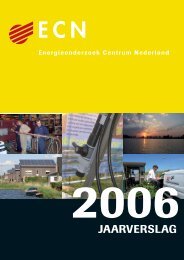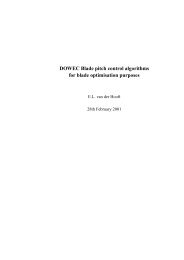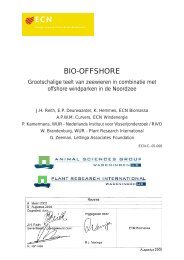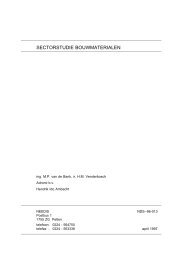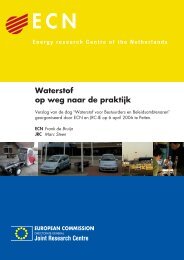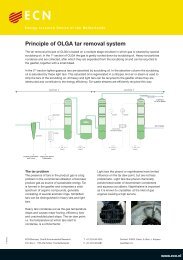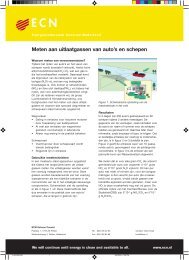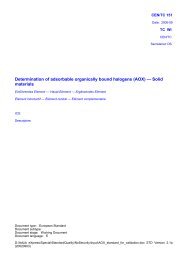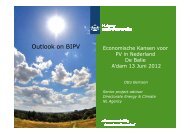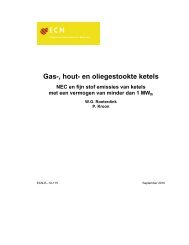PDF format (503 kB) - ECN
PDF format (503 kB) - ECN
PDF format (503 kB) - ECN
Create successful ePaper yourself
Turn your PDF publications into a flip-book with our unique Google optimized e-Paper software.
Scenario results<br />
The high electricity consumption for primary aluminium production results in a strong influence of the<br />
electricity generation on the CO2 emissions, as shown by figure 6. Thanks to the almost complete absence of<br />
process CO2 emissions, the bipolar electrode cell benefits more from a low electricity emission factor than Hall-<br />
HJroult does. The difference between primary and secondary routes is much smaller in case of a low electricity<br />
emission factor.<br />
A shift from the current<br />
Hall-HJroult cell to the Bipolar<br />
cell, accompanied by a zero<br />
electricity emissions factor,<br />
would mean an eight-fold reduction<br />
within primary production.<br />
In the same circumstances,<br />
a shift to secondary production<br />
means a thirty-fold reduction of<br />
CO2 emissions.<br />
Reduction Potential of the Sector<br />
The intermediate factor two reduction<br />
goal is attainable for<br />
steel, even with unfavourable<br />
external conditions. The<br />
CO2/t<br />
8<br />
6<br />
4<br />
2<br />
0<br />
Aluminium production<br />
CO2 emissions<br />
hall_heroult bipolar secondary<br />
Production route<br />
0 t CO2/GJe<br />
0.1 t CO2/GJe<br />
MIDREX based production route nearly realises 50 % reduction relative to the standard BF150 route, with a<br />
high electricity emissions factor and low scrap addition; high scrap addition further lowers emissions, beneath<br />
the 50 % goal. A factor 2 reduction in aluminium production is only attainable with a low electricity emissions<br />
factor.<br />
On the long term, steel production can meet the factor 10 reduction goal, if external parameters are favourable.<br />
CO2 removal is essential to attain the factor 10 reduction without changing the ratio between primary and scrap<br />
based production routes. The electricity emission factor and the scrap addition rate may be helpful for further<br />
reduction of emissions, but their influence is mainly to change the relative order of the production routes. On<br />
the long term the required changes of the infrastructure to enable CO2 storage are very probably attainable,<br />
though a social acceptation of the storage in aquifers and empty natural gas fields may raise difficulties.<br />
Compared with steel, aluminium lags somewhat behind; within the primary production routes a factor 8 is attainable<br />
with a low electricity emissions factor. Further reductions of emissions require a shift to scrap based<br />
production. If this is not attainable, extra reductions in steel production may compensate the deficiency in aluminium.<br />
Besides external factors, internal factors are likely to influence the choice of a production route. Of the production<br />
routes with considerable reduction potentials, COREX and CCF based routes present a logical step for<br />
primary steel producers, while DRI based routes are entirely different from the current primary production<br />
structure. On the other hand, DRI based routes might be a logical step for the current scrap based producers.<br />
MIDREX, Circofer and CCF could be regarded as Asafe bets@ as they always result in emission reductions,<br />
regardless of external parameters, while COREX requires CO2 removal to realise reductions at all. The CCF<br />
route has the advantage of its low costs, even in the removal scenarios.



